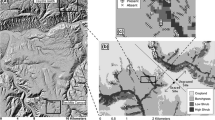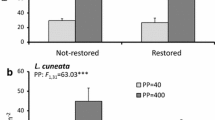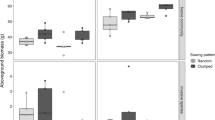Abstract
Despite the dramatic changes invasive plants cause to ecosystems and communities, factors that control dominance of invasive species after establishment in a community are poorly understood. Most active management relies on catastrophic disturbances of invasive-dominated communities to increase richness and diversity of plant communities. This study examines the importance of propagule dispersal and deer herbivory on continued dominance of Phalaris arundinacea after a non-catastrophic, short-term disturbance to monotypic stands of this invasive grass. The disturbance caused no change in P. arundinacea cover among treatments during any year of the study and, thus, simulates disturbance intensity more likely to be encountered in unmanaged settings. Despite the small disturbance, the combinations of disturbance + seeding and disturbance + seeding + deer exclusion caused greater species richness than controls even three years after disturbance. Increased invasion of P. arundinacea stands caused few effects on the dominant, as P. arundinacea biomass was unaffected after the first year. Selective herbivory by deer of species other than P. arundinacea increased the effects of disturbance and seeding, and aided in continued dominance of the grass. The tolerance of P. arundinacea for direct anthropogenic effects, including poor water quality and hydroperiod fluctuations, and indirect effects, such as increased herbivory by historically high deer populations, indicates the complexity of determining persistence of invasive species.
Similar content being viewed by others
References
Adjei MB and Pitman WD (1993) Response of the temperate perennial grass, reed canarygrass, to defoliation on a peninsular Florida spodosol. Soil Crop Science Society of Florida Proceedings 52: 1–4
Anderson R (1994) Height of white-flowered trillium (Trillium grandiflorum) as an index of deer browsing intensity. Ecological Applications 4: 104–109
Augustine D and Frelich LE (1998) Effects of white-tailed deer grazing intensity on populations of an understory forb in fragmented deciduous forests. Conservation Biology 12: 995–1004
Augustine D and McNaughton SJ (1998) Ungulate effects on the functional species composition of plant communities: herbivore selectivity and plant tolerance. Journal of Wildlife Management 62: 1165–1183
Balgooyen C and Waller DM (1995) The use of Clintonia borealis and other indicators to guage impacts of white-tailed deer on plant communities in northern Wisconsin, USA. Natural Areas Journal 15: 308–318
Baskin CC and Baskin JM (1998) Seeds: Ecology, Biogeography, and Evolution of Dormancy and Germination. Academic Press, San Diego
Bosy JL and Reader RJ (1995) Mechanisms underlying the suppression of forb seedling emergence by grass (Poa pratensis) litter. Functional Ecology 9: 635–639
Boutin C and Keddy PA(1993) Afunctional classification of wetland plants. Journal of Vegetation Science 4: 591–600
Brabec J and Pysek P (2000) Establishment and survival of three invasive taxa of the genus Reynoutria (Polygonaceae) in mesic mown meadows: a field experimental study. Folia Geobotanica 35: 27–42
Britton AJ, Carey PD, Pakeman RJ and Marrs RH (2000) A comparison of regeneration dynamics following gap creation at two geographically contrasting heathland sites. Journal of Applied Ecology 37: 832–844
Brown SC (1998) Remnant seed banks and vegetation as predictors of restored marsh vegetation. Canadian Journal of Botany 76: 620–629
Burke MJG and Grime JP (1996) An experimental study of plant community invasibility. Ecology 77: 776–790
Clark DL and Wilson MV (2001) Fire, mowing, and hand-removal of woody species in restoring a native wetland prairie in the Willamette Valley of Oregon. Wetlands 21: 135–144
Conchou O and Patou G (1987) Modes of colonization of an heterogeneous alluvial area on the edge of the Garrone River by Phalaris arundinacea. Regulated Rivers 1: 37–48
Connell JH and Slatyer RO (1977) Mechanism of succession in natural communities and their role in community stability and organization. American Naturalist 111: 1119–1144
Cross JR (1981) The establishment of Rhododendron ponticum in the Killarney oakwoods, s.w. Ireland. Journal of Ecology 69: 807–824
Duncan KW and McDaniel KC (1998) Saltcedar (Tamarix spp.) management with imazapyr. Weed Technology 12: 337–344
Dunn O (1964) Multiple contrasts using rank sums. Technometrics 6: 241–252
Farnsworth E and Meyerson LA (1999) Species composition and inter-annual dynamics of a freshwater tidal plant community following removal of the invasive grass, Phragmites australis. Biological Invasions 1: 115–127
Frame J and Morrison MW (1991) Herbage productivity of prairie grass, reed canarygrass and phalaris. Agronomy Journal 71: 627–630
Galatowitsch SM and van der Valk AG (1994) Restoring Prairie Wetlands: An Ecological Approach. Iowa State University Press, Ames, Iowa
Galatowitsch SM and van der Valk AG(1995) Reference revegetation during restoration of wetlands in the southern prairie pothole region of North America. In: Wheeler BD, Shaw SC, Fojt WL and Robertson RA (eds) Restoration of Temperate Wetlands, 129–142. John Wiley and Sons, Chichester, UK
Galatowitsch SM and van der Valk AG (1996a) Characteristics of recently restored wetlands in the prairie pothole region. Wetlands 16: 75–83
Galatowitsch SM and van der Valk AG (1996b) The vegetation of restored and reference prairie wetlands. Ecological Applications 6: 102–112
Galatowitsch SM, Anderson NO and Ascher PD (1999) Invasive-ness in wetland plants in temperate North America. Wetlands 19: 733–755
Galatowitsch SM, Whited DC, Lehtinen R, Husveth J and Schik K (2000) The vegetation of wet meadows in relation to their land-use. Environmental Monitoring and Assessment 60: 121–144
Gaudet CL and Keddy PA (1995) Competitive performance and species distribution in shoreline plant communities: a comparative approach. Ecology 76: 280–291
Gross KL (1990) A comparison of methods for estimating seed numbers in the soil. Journal of Ecology 78: 1079–1093
Kalkhan MA and Stohlgren TJ (2000) Using multi-scale sampling and spatial cross-correlation to investigate patterns of plant species richness. Environmental Monitoring and Assessment 64: 591–605
Kellogg CH and Bridgham SD (2002) Colonization during early succession of restored freshwater marshes. Canadian Journal of Botany 80: 176–185
Kellogg CH, Bridgham SD and Leicht SA (2003) Effects of water level, shade and time on germination and growth of freshwater marsh plants along a simulated successional gradient. Journal of Ecology 91: 274–282.
King SE and Grace JB (2000) The effects of gap size and disturbance type on invasion of wet pine savanna by cogongrass, Imperata cylindrica (Poaceae). American Journal of Botany 87: 1279–1286
Kolar CS and Lodge DM (2001) Progress in invasion biology: predicting invaders. Trends in Ecology and Evolution 16: 199–204
Lee JS, Ahn JH, Jo IH and Kim DA (1996) Effects of cutting frequency and nitrogen fertilization on dry matter yield of reed canarygrass (Phalaris arundinacea L.) in uncultivated rice paddy. American Journal of Agricultural Science 9: 737–741
Levine JM(2000) Species diversity and biological invasions: relating local process to community pattern. Science 288: 852–854
Lodge DM (1993) Biological invasions: lessons for ecology. Trends in Ecology and Evolution 8: 133–137
Marten GC and Heath ME (1985) Reed canarygrass. In: Heath ME, Barnes RF and Metcalfe DS (eds) Forages: the Science of Grassland Agriculture, 207–216. Iowa State University Press, Ames, Iowa
Marten GC, Jordan RM and Hovin AW (1976) Biological significance of reed canary grass alkaloids and associated palatability variation to grazing sheep and cattle. Agronomy Journal 68: 909–913
McIntyre S, Lavorel S and Tremont RM (1995) Plant life-history attributes: their relationship to disturbance responses in herbaceous vegetation. Journal of Ecology 83: 31–44
McJannet CL, Keddy PA and Pick FR (1995) Nitrogen and phosphorus tissue concentrations in 41 wetland plants: a comparison across habitats and functional groups. Functional Ecology 9: 231–238
Meyer AH and Schmid B (1999) Experimental demography of rhizome populations of establishing clones of Solidago altissima. Journal of Ecology 87: 42–54
Morrison SL and Molofsky J (1999) Environmental and genetic effects on the early survival and growth of the invasive grass Phalaris arundinacea. Canadian Journal of Botany 77: 1447–1453
Paveglio FL and Kilbride KM (2000) Response of vegetation to control of reed canarygrass in seasonally managed wetlands of southwestern Washington. Wildlife Society Bulletin 28: 730–740
Pierce SM and Cowling RM (1991) Dynamics of soil-stored seed banks of six shrubs in fire-prone dune fynbos. Journal of Ecology 79: 731–747
Reinartz JA and Warne EL (1993) Development of vegetation in small created wetlands in southeastern Wisconsin. Wetlands 13: 153–164
Riemenschneider V, Cordell TB and Allison B (1995) Impact of white-tailed deer on plant cover and biomass in Potato Creek State Park, St. Joseph County, Indiana. Proceedings of the Indiana Academy of Science 104: 35–41
Rooney T (1997) Escaping herbivory: refuge effects on the morphology and hoot demography of the forest clonal herb Maianthe-um canadense. Journal of the Torrey Botanical Society 124: 280–285
Schmitz DC and Simberloff D (1997) Biological invasions: a growing threat. Issues in Science and Technology 13: 33–40
Simberloff D and Von Holle B (1999) Positive interactions of non-indigenous species: pinvasional meltdown? Biological Invasions 1: 1–32
Stadler J, Trefflich A, Klotz S and Brandl R (2000) Exotic plant species invade diversity hot spots: the alien flora of northwestern Kenya. Ecography 23: 169–176
Stone CP (1985) Alien animals in Hawaii's native ecosystems: toward controlling the adverse effects of introduced vertebrates. In: Stone CP and Scott JM (eds) Hawaii's Terrestrial Ecosystems: Preservation and Management, 251–297. University of Hawaii, Honolulu, Hawaii
Symstad A (2000) A test of the effects of functional group richness and composition on grassland invasibility. Ecology 81: 99–109
Tilman D (1993) Species richness of experimental productivity gradients: how important is colonization limitation? Ecology 74: 2179–2191
Tilman D (1997) Community invasibility, recruitment limitation, and grassland biodiversity. Ecology 78: 81–92
Ussery JG and Krannitz PG (1998) Control of Scot's broom (Cytisus scoparius (L.) Link.): the relative conservation merits of pulling versus cutting. Northwest Science 72: 268–273
van der Valk AG, Bremholm TL and Gordon E (1999) The restoration of sedge meadows: seed viability, seed germination requirements, and seedling growth of Carex species. Wetlands 19: 756–764
Vitousek PM (1990) Biological invasions and ecosystem processes: towards an integration of population biology and ecosystem studies. Oikos 57: 7–13
Vitousek PM, D'Antonio CM, Loope LL and Westbrooks R (1996) Biological invasions as global environmental change. American Scientist 84: 468–478
Voss E (1972) Michigan Flora: Part I. Cranbrook Press, Bloomfield Hills, Michigan
Voss E (1985) Michigan Flora: Part II. Cranbrook Press, Bloomfield Hills, Michigan
Voss E (1996) Michigan Flora: Part III. Cranbrook Press, Bloomfield Hills, Michigan
Williamson M (1996) Biological Invasions. T.J. Press, Padstow, UK
Zar J (1999) Biostatistical Analysis. 4th edn. Prentice-Hall, Upper Saddle River, New Jersey
Zeiders KE and Sherwood RT (1985) Environmental interactions among reed canarygrass genotypes for nutritive value, height and disease severity. Agronomy Journal 77: 94–98
Author information
Authors and Affiliations
Corresponding author
Rights and permissions
About this article
Cite this article
Kellogg, C.H., Bridgham, S.D. Disturbance, Herbivory, and Propagule Dispersal Control Dominance of an Invasive Grass. Biological Invasions 6, 319–329 (2004). https://doi.org/10.1023/B:BINV.0000034606.84830.d5
Issue Date:
DOI: https://doi.org/10.1023/B:BINV.0000034606.84830.d5




